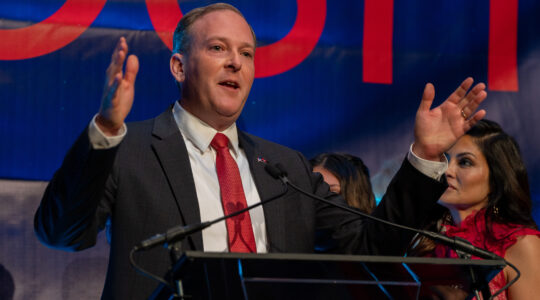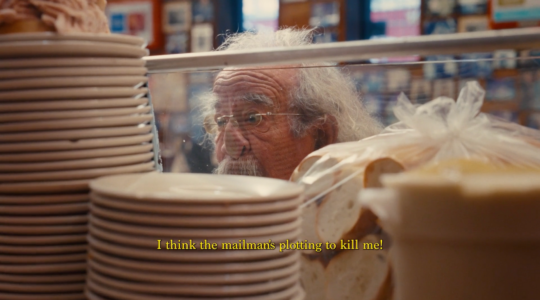Phillipe Karsenty, a French media monitor who is appealing his conviction in France for libelously charging that the state television’s news footage of the intifada’s most iconic death of a Palestinian child, supposedly by Israeli bullets, was either faked or staged by the Palestinians, is getting increasing support, he says — but not from the Israeli ambassador to France.
Karsenty, speaking in New York to The Jewish Week, said Israel’s ambassador to France, Daniel Shek, refuses to even shake Karsenty’s hand, let alone support him.
According to Karsenty, “Shek seems more interested in going to cocktail parties than to defend the image of the country he is supposed to serve.” Karsenty says he was told by Shek, “Leave me alone. I’m not interested by this case. I
don’t want to hear about you.”
Attempts to reach Shek have been unsuccessful.
One possible light on Shek’s desire to give Karsenty the cold shoulder could be found in a report in Yediot, last April, in which Shek said the French “are tired of hearing about our problems,” and the growing French apathy about the Mideast “is not at all bad for Israel.”
Haaretz has reported, “Israel has avoided relating to the [Al-Dura] incident, mostly because of the Foreign Ministry’s recommendation that renewed handling of the affair would not help Israel’s image in any case.”
The IDF, however, has sent the French court a letter of support for Karsenty. And the Government Press Office in Israel has determined that the Sept. 2000 death of Mohammed Al-Dura was staged.
Israeli Prime Minister Ehud Olmert’s office appears to be distancing itself from the case, saying it had not seen or authorized the Government Press Office letter.
Natan Sharansky, writing in The Wall Street Journal (Oct. 7, online) said, Karsenty’s first trial “passed almost unnoticed in Israel, to the apparent detriment of Mr. Karsenty’s case. In his ruling in favor of France 2 [a French television station], Judge Joel Boyer five times cited the absence of any official Israeli support for Mr. Karsenty’s claims as indication of their speciousness.”
Karsenty charges that Shek is good friends with Charles Enderlin, a prominent broadcaster for the France 2 station, who with Enderlin, is suing Karsenty. Enderlin did a studio voice-over commentary for the 59-second France 2 newsreel of the shooting that was broadcast around the world seven years ago. Enderlin was not at the Gaza crossroads at the time of Al-Dura’s alleged death but relied on information from a Palestinian cameraman hired by France 2, a cameraman whose credibility has since been widely questioned.
Daniel Seaman, director of Israel’s Government Press Office, wrote in his Oct. 2 letter that the media fraud was staged with the France 2 cameraman, Tilal Abu-Rehama, who lives in Gaza.
The French appeals court has ordered France 2 to submit Rehama’s unedited 27-minute film by mid-November.
Karsenty described the Al-Dura “lie” as perhaps the most important French Jewish case since the Dreyfus trial. Not that Karsenty himself, he hastens to add, is Dreyfus, “but Israel itself is Dreyfus.”
He said that while Dreyfus did not die as a result of his conviction, “Jews in Israel and all over the world have died because of this,” most notably Daniel Pearl, in whose death video one can see, over his shoulder, a poster of Al-Dura’s alleged death.
Karsenty, 41, a former stockbroker, added, “Dreyfus was small compared to this. At that time,” in a case lasting from 1894 to 1906, “the French establishment was working to protect the army, the most important, respected and powerful institution in France. What is the most important, respected and powerful institution in France now? The media. The French establishment is now working to protect the media.”
Herzl, said Karsenty, began his Zionist dream when, as a journalist covering the Dreyfus trial he heard crowds in the streets chanting “Death to the Jews.” After the Al-Dura broadcast, said Karsenty, “we’ve heard crowds in the streets of France once again yelling ‘Death to the Jews.’ The deligitimization of Israel started with this image of Al-Dura. There are many lies against Israel but this may be the biggest.”
This past week, in the Columbia Journalism Review online (Oct. 3), Gal Beckerman wrote that once the second intifada exploded in 2000, “there was one media event that, indisputably and instantaneously, fanned the flames and primed the Palestinian people and the wider Arab world for confrontation: the televised death of twelve-year-old Mohammed Al-Dura. The fifty-nine seconds of edited footage, aired on France 2, was repeated thousands of times on September 30, 2000, and in the days and weeks that followed.”
After once dismissing the accusations of conspiracy theorists, the CJR’s Beckerman now concludes, “I imagine the tapes [demanded by the court] will probably show that the Israeli soldiers did not kill the boy, and that the cause of his death was either unclear or the result of a Palestinian bullet. Either way, it should be pretty obvious that when you’re dealing with such murkiness, the best thing to do is throw as much light as possible on the story. It just seems strange that it has taken two court cases to force France 2 to do just that.”
Sharansky, in the WSJ, wrote that Israel “must play an active role in uncovering the truth.”
In the coffee shop of the Park Regency Hotel, Karsenty took out a laptop with news films, some broadcast, some unedited, that clearly show a pattern of fraud relating to the Al-Dura case. Although the father of Al-Dura later claimed to have been riddled and mutilated by Israeli bullets, and the France 2 cameraman speaks of an extended and bloody Israeli assault on the father and child, the broadcast shows both father and son unbloodied.
Even as the IDF was supposedly firing, film shows other Palestinians walking casually through the intersection in the line of Israeli fire; there was no indication that the Israelis were firing at all.
The bullets seem to come from the area of the France 2 cameraman, where only Palestinian gunmen were stationed. Palestinian civilians seem to be directing the Palestinian militiamen in the scene. Although there were Reuters and Associated Press cameramen at the shooting, as well as France 2, there was no footage of the boy bleeding or dying, only cowering into his father. At one point, after the boy’s alleged death, he seems to be peeking from under his hands.
The New York Jewish Week brings you the stories behind the headlines, keeping you connected to Jewish life in New York. Help sustain the reporting you trust by donating today.




